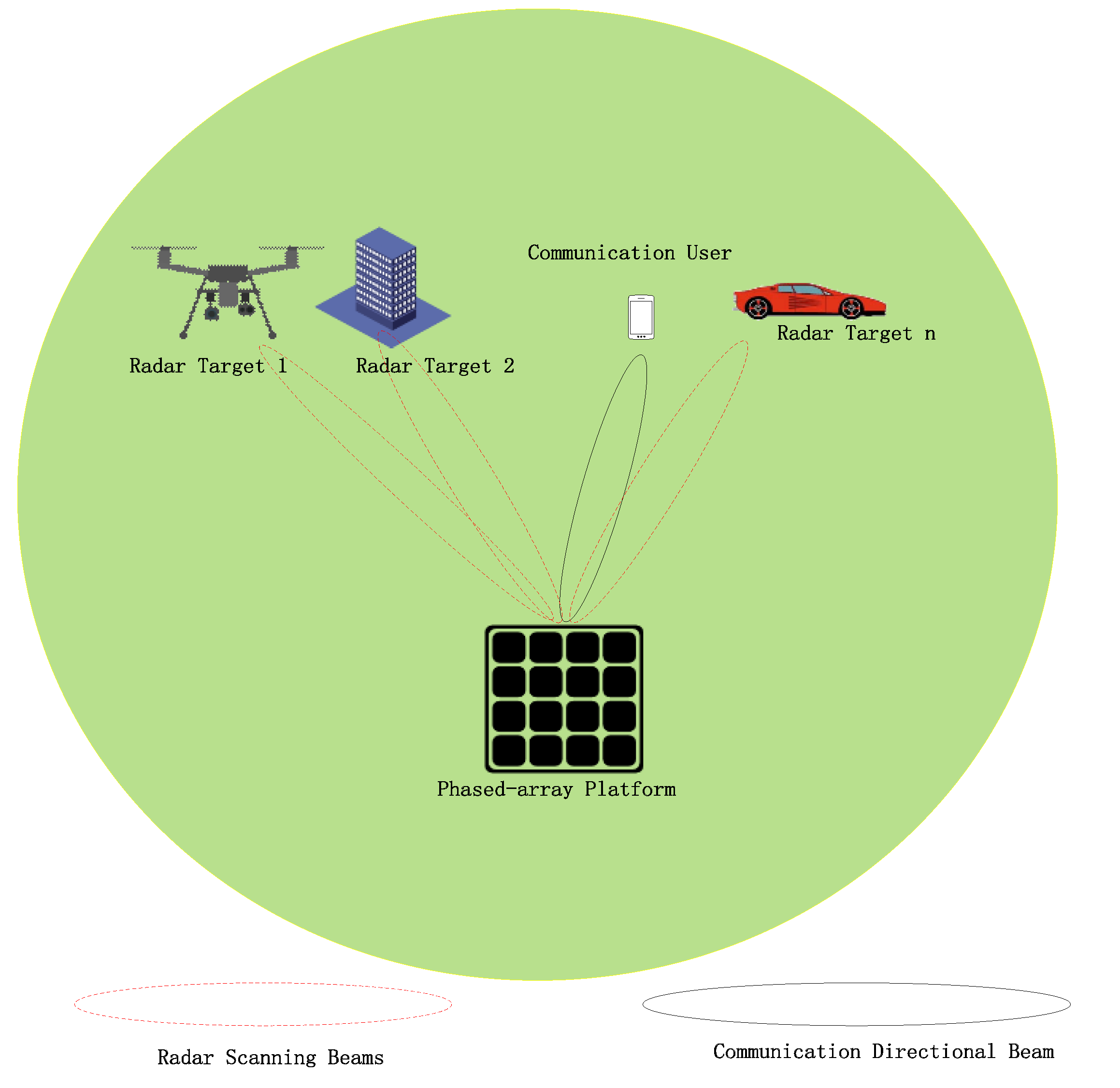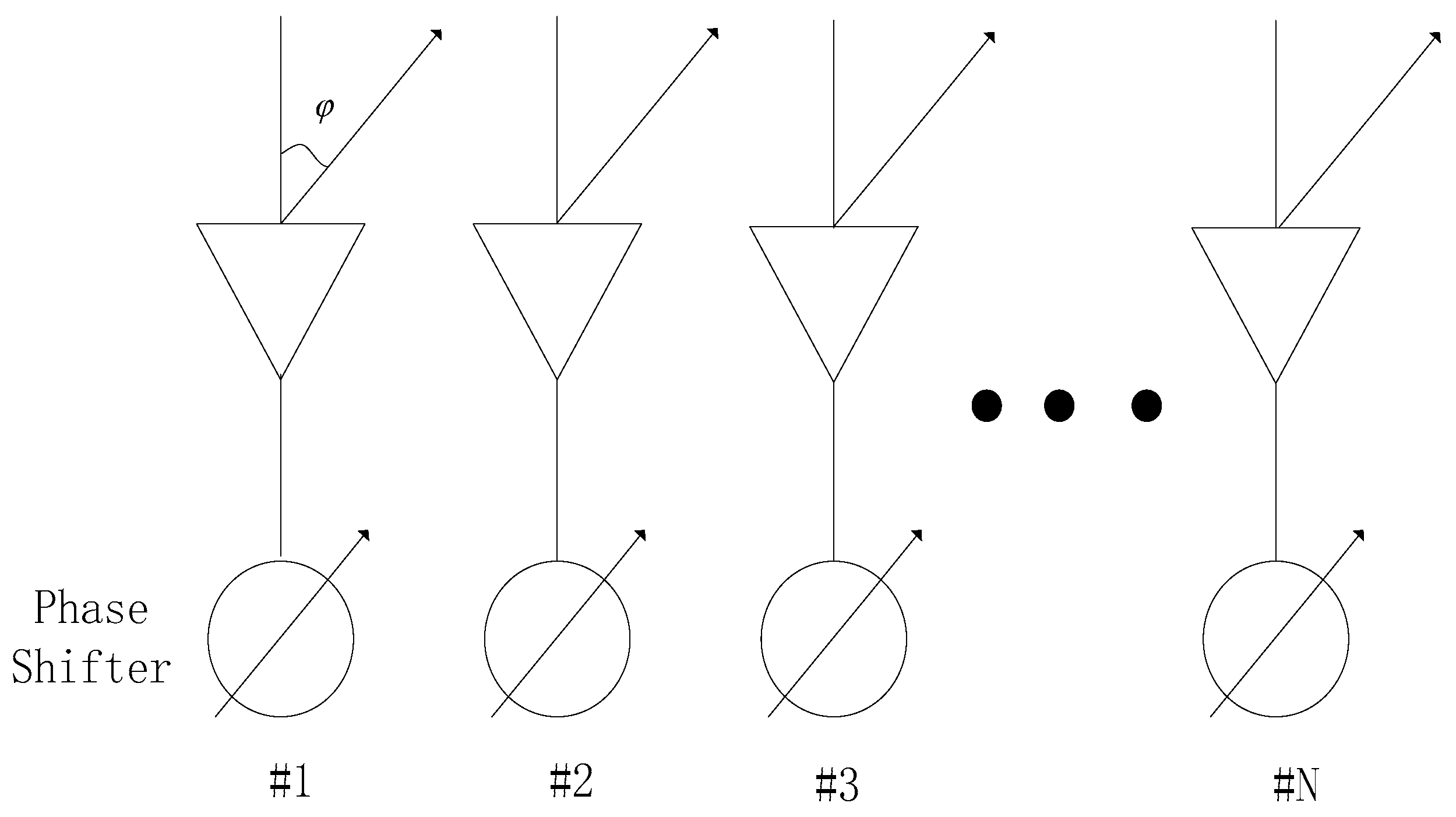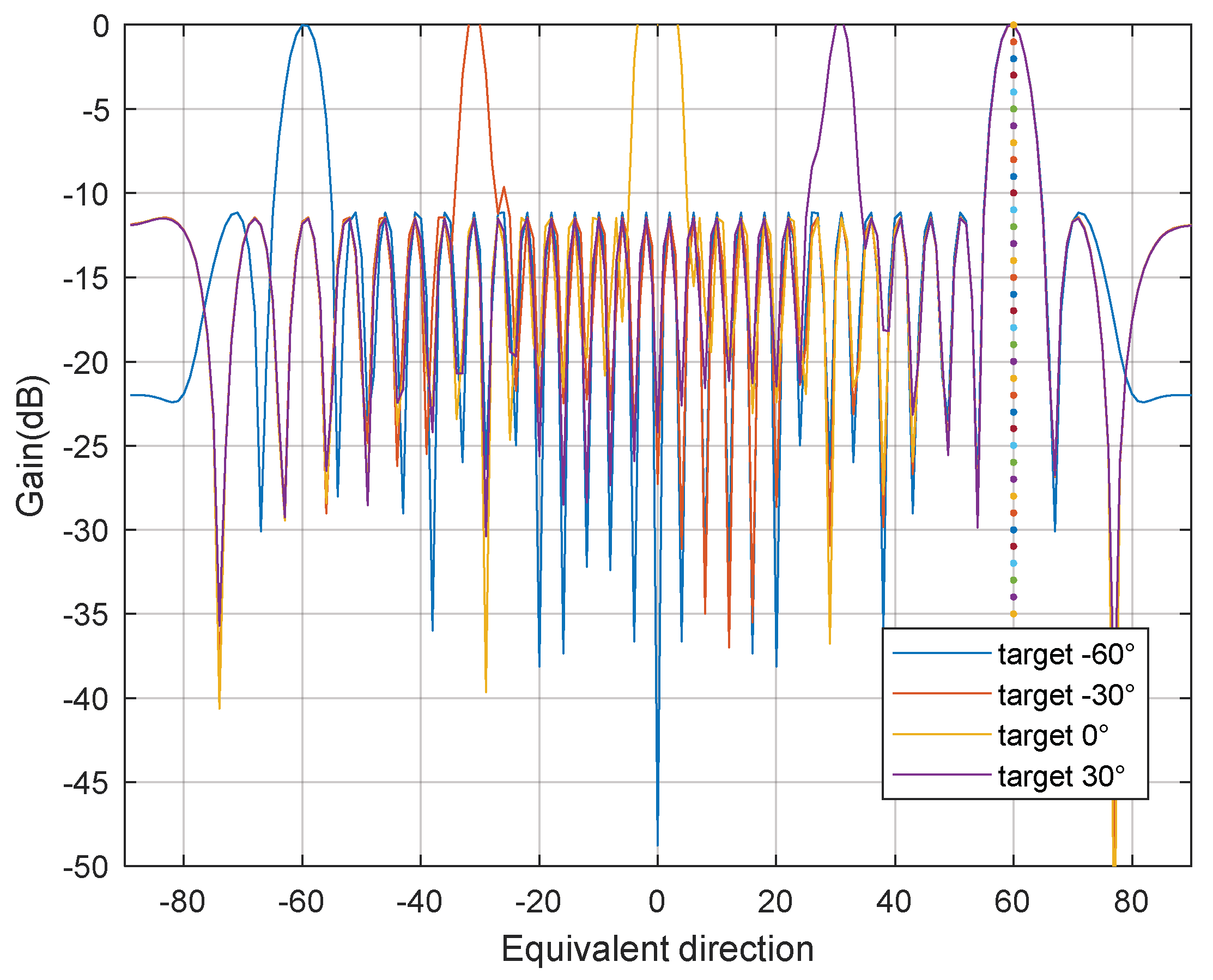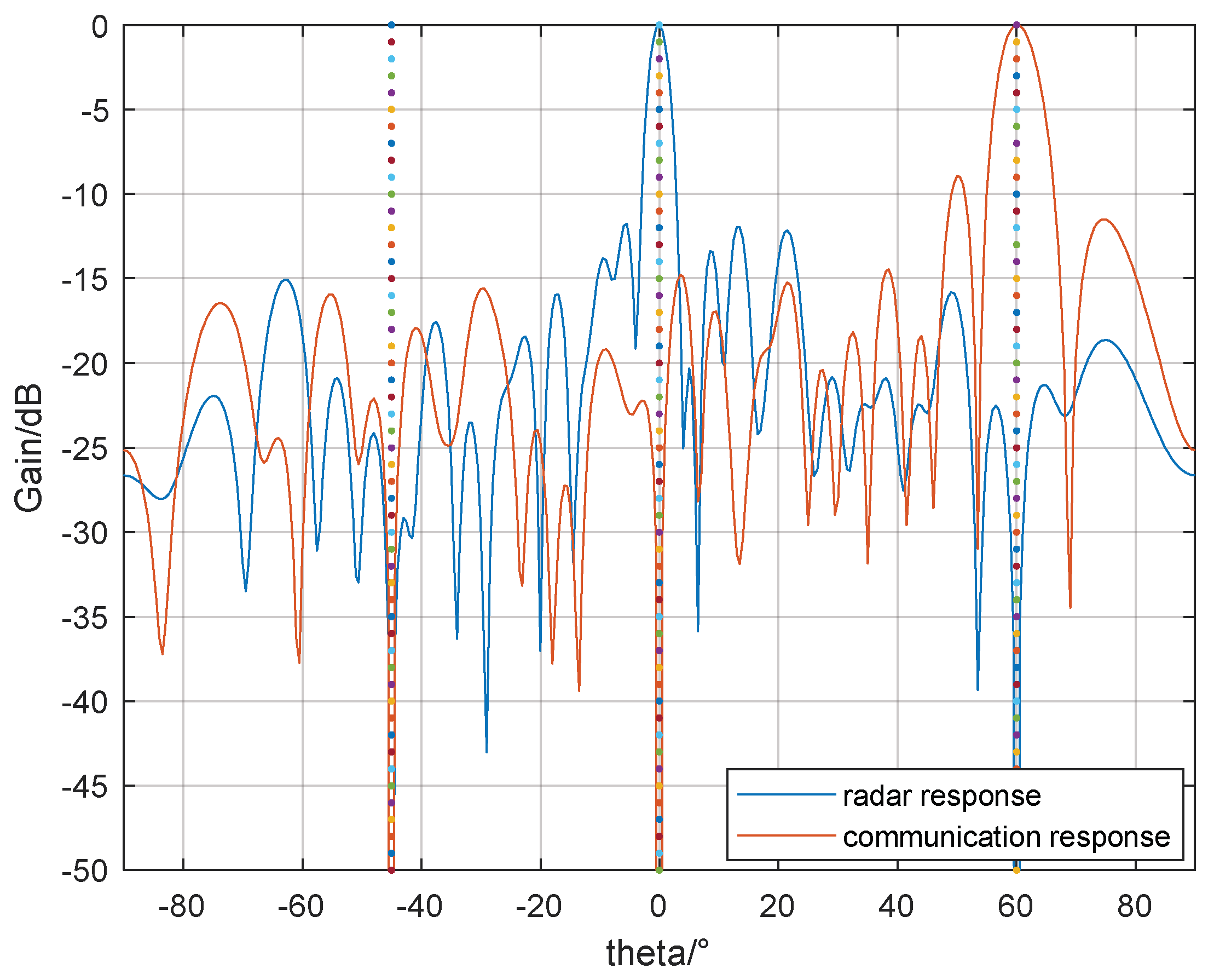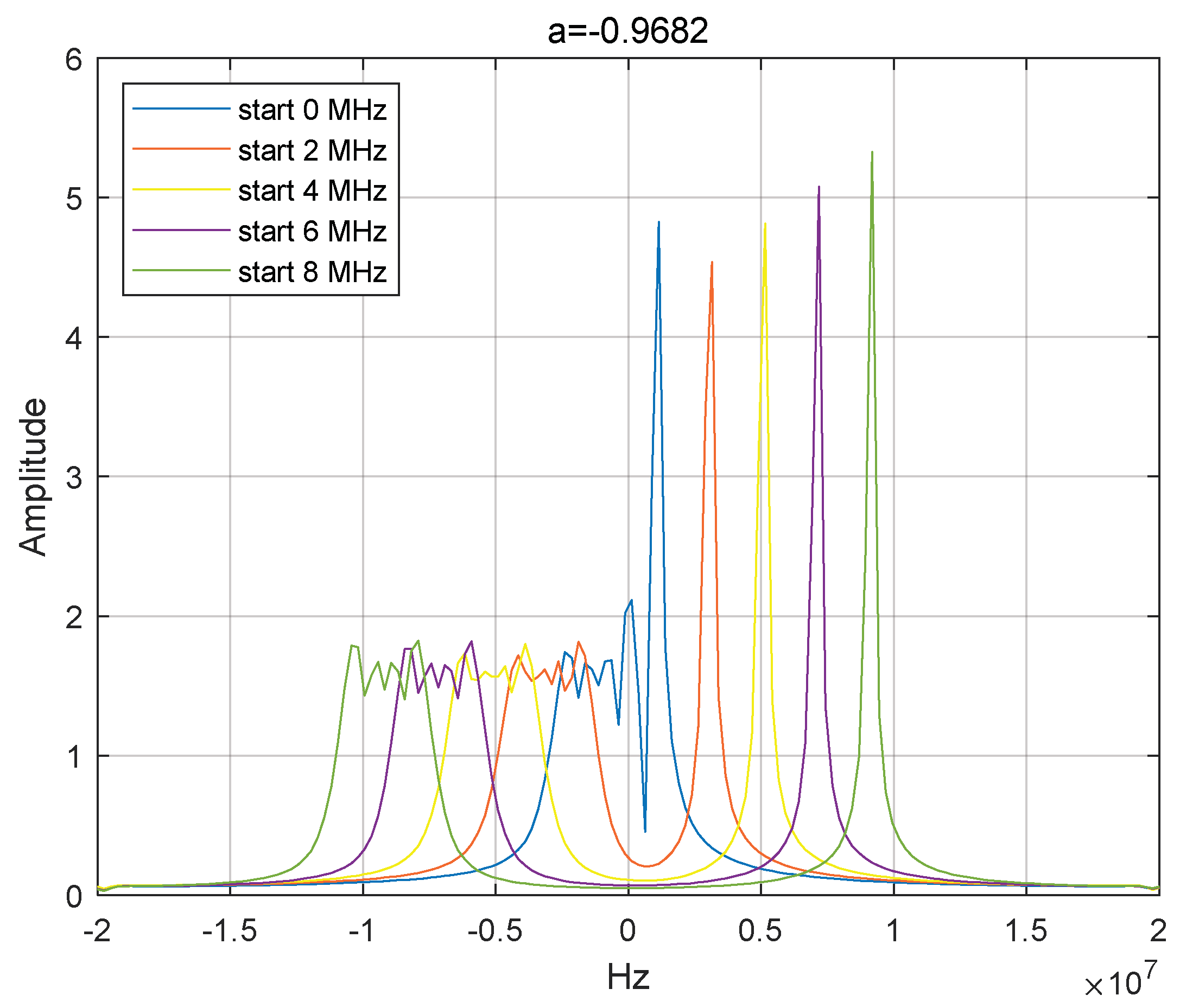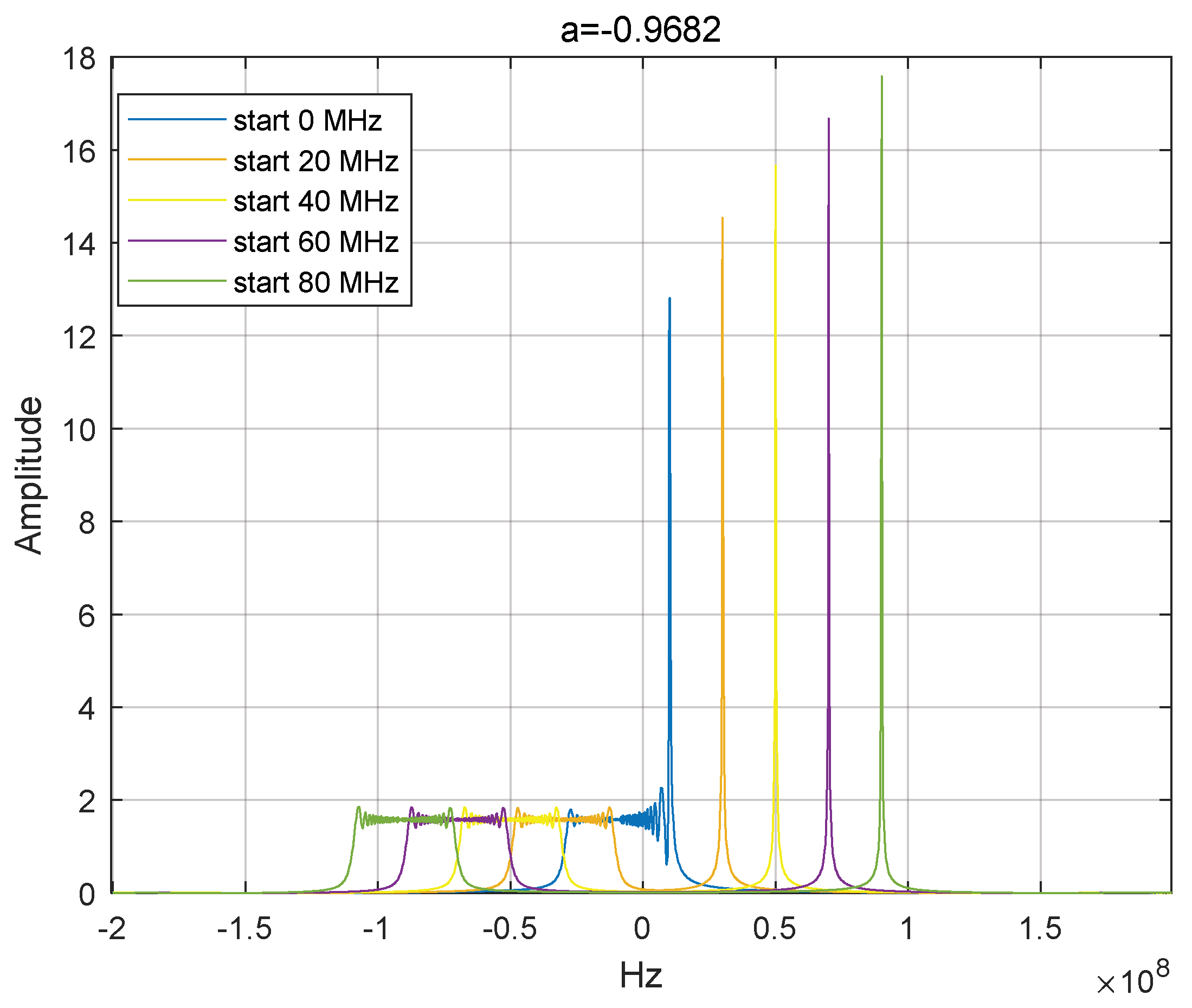1. Introduction
The increasing scarcity of spectrum resources has gradually become an important issue in the development of modern wireless communication technology with the advent of 5G and the dramatic increase in wireless communication terminals [
1,
2,
3]. In this application environment of scarce spectrum resources, the study of reusing existing spectrum resources has become a hotspot of current research. Radar communication integration technology is an important research area for reusing the existing wireless spectrum. Radar and wireless communication technology belong to the important field of radio technology application. Although their use of the spectrum gradually overlaps, the two have undergone a long period of independent development. As a result, their technical indicators are in a state of mutual fragmentation. Each technology consumes a large amount of spectrum resources, energy resources, and space resources individually. With the progress of wireless technology, the miniaturisation and high-frequency development of radar and communication have led to the convergence of their hardware architecture, signal processing mode, and antenna array development mode [
4,
5]. The primary technical approach to integrating radar communication technology can be summarised as follows: (1) Module coexistence mechanism: radar and communication utilise distinct spectrum resources and temporal domains, share local hardware resources, and possess different waveforms and transceiver mechanisms. The critical technologies encompass time domain allocation, signal transmitting, and power allocation. (2) Spectrum-sharing mechanism: Radar and communication share the same spectrum resources but use sesidete hardware resources. Each design corresponds waveforms for radar detection and communication in the common time domain or airspace, while minimizing interference between the two. Key technologies include pre-coding design, receive anti-interference design, and dual-signal sesidetion at the receiving end. (3) The complete integration mechanism utilizes the same hardware resources, spectrum resources, and waveform design for both radar and communication. There is no distinction between the two in terms of the time and frequency domains. The integration technology eliminates mutual interference and dual signal sesidetion, allowing the received signal to be considered as both a radar detection signal and a communication signal. The key technologies involved are integrated system waveform and beam-pattern design, as well as integrated communication receiver design. The complete integration of radar communication represents the main direction for the development of radar communication integration.
Phased-array radar is currently the mainstream technology in radar systems, which enables multiple beam directions and intensities for radar detection. This technology is free from mechanical inertia constraints, resulting in significantly improved scanning speeds. Moreover, its beam control is both flexible and user-friendly, making it a widely adopted modern radar technology. Phased-array radar has the capability to scan a full range of airspace. In the field of radar communication integration technology, while the integration of waveforms for single antennas is mature, using mechanical scanning radar to achieve integration function leads to a lower communication efficiency and limited scanning speed, along with the shortcoming of communication and radar function in the same direction. In comparison, phased-array radar has several advantages, including a flexible beam design, a wide range of use, and the controllability of the side lobe power. It also has the ability to achieve multiple beams simultaneously for both radar and communication functions. This paper aims to utilize phased-array radar as the hardware basis to achieve an integrated system for beam-pattern design. The system function schematic diagram is shown in
Figure 1.
The design of beams for phased-array antennas is a well-established research field. The fundamental principle utilises the phased-array feed network during transmission to achieve a distortion-free beam in the desired direction while simultaneously suppressing the side lobe power of the beam. The aim is to eliminate clutter interference in undesired directions during the beamforming, and to design for zero sagging in directions of interference and undesired directions. The CVX optimisation toolbox was utilised in the literature [
6] to minimise the peak of the side-lobe level when designing the beam pattern for beam formation in phased-array radar. Study [
7] presented an adaptive beam synthesis technique for producing a phased-array radar beam that can alter its direction as the interference direction shifts. Study [
8] presents a method for synthesising beams in reconfigurable arrays with two-dimensional geometry, where the algorithm constrains the power of the array. The aforementioned techniques solely address diverse radar beam scenarios and are tailored towards beam-related use within the radar field. Study [
9] presented a beam-fouling architecture for phased-MIMO hybrids. The architecture initially divides subarrays and distributes the realization of radar beams and communication beams. Orthogonal waveforms are sent between subarrays, while phased-array coherent signals are sent inside subarrays to achieve the performance trade-offs of phased arrays and multiple-input/multiple-output (MIMO) integer columns. Studies [
10,
11] investigated the technique of multiple beam commonality synthesis for phased-MIMO hybrid arrays. This technique enables the system to optimize both radar and communication beams simultaneously. Study [
12] examined the methodology and effectiveness of quantification in multi-beam systems. A comparison of the characteristics of the different beam methods is shown in
Table 1.
The aforementioned method [
9,
10,
11] for integrated beams in phased-MIMO radar communication primarily capitalises on the MIMO radar’s high degree of freedom and the ease of implementing coherent signals in phased arrays. While it is easier to realise the beam direction within subarrays and to have different subarrays distribute radar and communication beams, meeting waveform orthogonality between subarrays increases engineering difficulty. Additionally, eliminating mutual interference between radar beams and communication beams must also be addressed. Aiming to tackle the aforementioned beam design issues, this paper presents a straightforward design approach for the beam direction transmitting/receiving beam pattern in a phased-array integrated system. Firstly, based on phased-array radar, the phased-array integrated system transmits the main radar signal and communication signal simultaneously, with the remaining area being defined as the side lobe. Secondly, the radar and communication main lobes’ direction, width, and power are designed. The integrated system’s reduction is then taken into account. Then, to decrease the influence of the beam’s side lobe as the objective function, one can create a convex optimization problem and use the convex optimization toolbox to solve it, and obtain the optimal weight matrix. Finally, the communication main lobe direction remains unchanged during the repeated transmission of the integrated waveform pulse. The communication data are updated, and the radar main lobe scanning direction is changed. This enables the integrated system to achieve directional communication and radar omni-directional detection at the same time. The transmit beam pattern method is shown in
Figure 2.
Beamforming is a key element of signal processing for an integrated system, allowing the integrated antenna array to receive signals in a specific direction and mitigate interference from other directions. Adaptive beamforming typically provides greater directivity and improved interference resistance compared to conventional beamforming. This paper utilises the well-established linear constrained minimum variance criterion (LCMV) adaptive beamforming to achieve radar signal and communication signal beamforming. Unlike the conventional multi-beam MIMO radar communication integration scheme, the phased-array integration system presented in this paper features both a radar transmission panel and a communication transmission panel, enabling detection and communication functions, respectively. When the signal is received, the beamforming technique implements target echo and duplex communication functions. Both the radar main and communication main lobe employ the same integrated waveform and carry the same communication data, with only the direction pointing and power differing. There is no interference between multiple beams, which significantly reduces the complexity of waveform design.
The integrated system for radar and communication in a phased array accomplishes simultaneous communication and radar detection using multiple beams. The radar detection function is similar to that of traditional phased-array radar, but the design and reception of an integrated waveform using the phased-array system is a challenging task. As the linear frequency modulation (LFM) radar waveform is a commonly used waveform, this paper focuses on the development and reception of the integrated waveform based on LFM. Through a comparison of integrated signals such as LFM-MSK, LFM-CPM, LFM-8PSK and LFM-BPSK, as proposed in the existing literature [
13,
14,
15,
16], the integrated waveform used in this paper is LFM-BPSK. This waveform considers both the great detection performance of the LFM radar waveform and the excellent communication performance of the BPSK. In prior analyses of the literature [
13,
14,
15,
16,
17], greater emphasis has been given to the development and performance analysis of LFM-type integrated waveforms, with little consideration given to the demodulation process of the integrated waveform data that utilise LFM as the carrier. Since the LFM carrier shifts frequency over time, its collection of waveforms can be considered as a series of brief LFM waveform collections. Consequently, the data extraction approach for the LFM carrier varies from the regular carrier extraction data approach. The crucial technology relies on building segmented reference signals. When creating the segmented matched filter, its tuning frequency remains fixed, with the determination of the initial frequency information of the integrated waveform set being key to constructing the matched filter. In this paper, we present a set of judgements based on the fractional Fourier transform (FRFT) that can extract the initial frequency from the LFM-BPSK waveform set, and design the reference signal.
The main contributions of this paper are as follows:
- (1)
A method for designing a beam pattern with integrated beamforming for phased-array radar communication is proposed. This method uses a phased-array antenna to generate both a radar scanning beam and a communication directional beam simultaneously. The radar beam’s scanning direction changes with each packet update, achieving both an omni-directional radar detection function and a directional communication function.
- (2)
In the integrated beamforming scheme, LCMV adaptive beamforming is utilised to implement radar and communication functions. These functions are implemented, respectively, to form a null point in the undesired direction and to ensure better reception of the input signals in the intended direction.
- (3)
For the integrated waveform LFM-BPSK, this paper proposes using FRFT to estimate the initial frequency and construct matched filtering in the receiver design to achieve the reception function of communication data. This approach enhances objectivity and clarity in the design of the communication system.
The paper is structured as follows:
Section 1 provides an introduction,
Section 2 outlines the model and scheme for the integrated system,
Section 3 presents the initial frequency parameter estimation scheme for the integrated signal set,
Section 4 describes the experiments and simulations to evaluate the estimation performance of the beam fouling and communication receiver, and
Section 5 summarizes the characteristics of the integrated system.
2. Radar Communication Integration System Mode
In this study, we utilise phased-array antenna technology, equipped with both transmitter and receiver modules on each array antenna, to attain the disseminated power transmission of the complete beam. The system utilises the phase shift scanning technique to alter the excitation phase of the array antenna. This results in achieving the optimal distribution of energy in space by controlling the pointing and intensity of different beams. The basic principle of the phased-array radar communication integration system can be simply analysed by analysing the principle of the array antenna. The phased-array integration system’s principle is depicted in
Figure 3. It is assumed that
-array-element antennas combine to form a one-dimensional linear phase shifter antenna of the phased array. All array elements are non-directional, point radiation sources, and all the inputs’ array feeds are equal-amplitude and same-phase feed signals. The assumed phase shift of each phase shifter is 0,
,
,
, etc. The
-element array antenna is uniformly linearly distributed with each array element, spaced by
, which is half-wavelength. The phase difference between the feeds of each neighbouring array element is
.
In
Figure 3, the
angle indicates the deviation from the normal direction, and the field strength,
, at a test point in the far field can be expressed as the sum of the field strength vectors,
, of each array element at that point in the direction of deviation,
, from the normal. Then, the field strength at the test point can be expressed as follows:
In Equation (1), because all the array elements are fed with equal amplitude, the difference in the amplitude of each array element to the far-field point can be ignored, and it can be assumed that the amplitude of each array element fed to the point is equal, which is expressed by the symbol
. Then, if we take the phase of the radiated field phase of the no. 1 array element as the reference phase,
, combined with the phase difference of each array element, the field strength at the test point can be rewritten as
In Equation (2),
is the phase difference in radiation of neighbouring array elements caused by the wave range difference,
is the phase difference of neighbouring phases,
is the phase precession of
and
, and
is the phase lag of
and
. In the antenna array element, the phase difference of the radiated fields of the neighbouring array elements is
. According to the isoperimetric summation and applying Yura’s formula, the vector sum at the test point can be written as
In Equation (3), when the phase difference is
, neighbouring array elements are cancelled by the phase difference of the wave range, the components are summed in the same phase, and the radiation intensity at the test point in the far field is at the maximum, which is
So, the normalised direction diagram of the array antenna can be expressed as
When the phase difference, , between the neighbouring array element is 0, the normal deviation angle, , is 0, on behalf of the array element’s equal-amplitude in-phase feed, at this time, , that is, the maximum value of the direction in the beam pattern of the normal array element. If the phase difference is , the maximum direction should be shifted, and the shift angle is determined by the phase shift, . By changing the phase shift, , the beam direction can be changed to achieve the beam synthesis of the uniform linear-array (ULA) antenna and achieve the purpose of phased-array radar wave-speed scanning.
On the basis of ULA, rectangular-array antennas, circular-array antennas, hexagonal-array antennas, random-array antennas and three-dimensional-array antennas, among other phased-array modes, have been developed. These can be flexibly applied to a variety of work situations. Although the beam-pattern expression of planar rectangular arrays and three-dimensional arrays differs from that of a ULA, its working principle and beam-pattern formula can be derived based on the ULA. However, this derivation is not described in detail within this paper. When the integrated system of phased-array radar communication is operational, the radiation unit of the array antenna is controlled to generate multiple beams in varying directions. This enables a multidirectional scanning, detection, and communication capability. Additionally, the power output of the multiple beams can be adjusted in real time, and flexible function switching is possible within the airspace range.
2.1. Design of Integrated Transmit Beam Pattern
The design of the transmit beam pattern of the integrated system is one of the important research contents of the radar communication integrated system, which includes the design of the array antenna, the optimisation theory, and the transmission equation of the radar communication. In this paper, the designed radar communication integrated transmit beam-pattern technology, using phased-array radar antennas for the corresponding beam-sending direction. The system for transmit beam patterns features both a radar main lobe and a communication main lobe. Each main lobe sends an integrated waveform with both communication and radar detection capabilities. By adjusting the beam pointing and power intensity, the system achieves the simultaneous integration of radar and communication functions. The design method for conventional beam patterns suffers from significant fluctuations in the main and side lobes. This issue impedes the creation of the beam pattern for the integrated system. The approach implements restricted side lobes for improved design. To address this problem, this paper utilises the principles of the convex optimisation theory to develop a new beam design method.
Conventional radar antenna beam-pattern design typically employs the traditional side-lobe minimisation algorithm, which revolves around the principle of minimising the side lobe:
- (1)
The direction of the main lobe of the beam pattern can be output without any distortion;
- (2)
The side panel of the beam pattern that is external to the main lobe is intended to be level;
- (3)
An optimisation process is employed to attain the reduction of the side-lobe level.
In this method, it is assumed that the coverage of the array antenna is , the main lobe direction is , and the main lobe width is . Then, the angle range of the main lobe of the whole beam pattern is , and the range of the side lobe is .
The orientation vector of the array antenna is
, and the weighting vector of the beam pattern is
; then, the design of the beam pattern of the array antenna can be modelled as a convex optimization problem:
On the basis of the radar array beam emission direction, the integrated beam emission direction design steps in this paper are as follows: Firstly, the integrated transmit beam must be divided into the radar main lobe area and communication main lobe area within the airspace. From there, the width of both the radar and communication main lobes must be determined. It is important to ensure that neither the radar nor the communication main lobes have any distorted output. Finally, an optimisation problem can be formed by using the reduction of the side lobe in other areas as the objective function. Finally, the convex optimisation toolbox should be employed to solve for the globally optimal weight vector in the array beam synthesis. The biggest advantage of this method is that it uses only one convex optimisation theory, and it can take into account the direction of the radar main lobe and the communication main lobe on the basis of reducing the level of the side lobe.
The beam pattern for the main lobe and communication main lobe can be customized for beam synthesis by altering the quantity, width, and orientation of the communication main lobe, without compromising the radar main lobe’s beam-pattern accuracy.
In this integrated beam synthesis method, assuming that the coverage of the array antenna is
, the radar main lobe direction is
, the main lobe width is
, the communication sub-lobe direction is
, and the communication sub-lobe width is
; then the angle range of the main lobe of the entire whole array is
, the communication sub-lobe range is
, and the range of the rest of the side lobes is
. The weighted vector of the direction is
, and the array guidance vector is
; then, the design of the direction of the integrated system array antenna can be modelled as a convex optimization problem:
In Equation (7), is the power ratio of the communication main lobe and the radar main lobe, the range of values . In practical engineering applications, the number of communication main lobes can be single, or it can be more than one, and the power ratio coefficient, , can also be adjusted to achieve different communication transmission power for different integration work occasions; this paper assumes that the ratio coefficient is 1.
3. Parameter Estimation for Communication Receiver
The radar communication integrated signal can simultaneously achieve target detection and communication tasks. For the radar detection capabilities of the integrated system, previous studies within the literature [
13,
14,
15,
16,
17] have conducted more thorough analyses. However, the communication reception performance of the LFM-based integrated signal has been largely overlooked. For the integrated waveform signal based on LFM, it can be considered as a distinct communication mode where the LFM functions as the carrier. This mode significantly differs from the conventional carrier communication mode. In traditional carrier communication, the frequency of the carrier signal remains constant, and the baseband communication information can be extracted using the de-carrier method, which has a well-established technical foundation. However, the LFM carrier frequency fluctuates over time during operation. In practical engineering applications, the LFM wave signal cannot be eliminated using the conventional carrier removal method, necessitating the consideration of an alternative approach for removing the LFM carrier. By analysing the ideas and expressions of the LFM-BPSK integrated waveform design, it is apparent that the information bits are embedded within various sub-pulses of the linear FM signal. The integrated signal can be considered as the combination of multiple brief linear FM signals, with each being a short linear FM signal that undergoes a change in initial frequency and a jump in phase information.
From the communication point of view, the integrated-signal LFM-BPSK-carrying
bit can be regarded as the signal set of multiple micro-LFMs, with different initial frequencies,
, different phase information, and the same frequency modulation with the same signal set expression:
Equation (17) can be regarded as a set of LFM waveform signals with different initial frequencies and different phases, but with the same tuning frequency, and the frequency modulation is known. Inspired by the literature [
16,
18,
19], when receiving a sequence of LFM waveform set signals, the communication receiver must determine the initial frequency of the waveform set and create a segmented reference signal based on both the initial frequency and the tuning frequency. It is assumed that the communication receiver is located in the far-field of the radar transceiver and comprises a single receive element. The received signal at the communication receiver is a time delay,
, of the transmitted signal, as follows:
Assuming that the delay,
, can be estimated in directional communication. By utilizing the estimated parameters, the reference signal at the receiving end of the communication can be expressed as
The communication code element value be accurately determined as
stands for the complex conjugate. Thus, estimating the initial frequency parameter of the integrated waveform set is crucial to the communication receiver design. The schematic diagram of the communication receiver is shown in
Figure 4.
The FRFT provides the signal’s Fourier transform representation in the time–frequency plane. It is formed by rotating the coordinate axis anti-clockwise from the origin through any angle [
20]. The FRFT is a time–frequency analysis method that provides information on a signal’s time and frequency domains. It is particularly effective in the analysis of LFM signals due to its superior aggregation capabilities. In the literature [
21], FRFT was used to study the LFM signal set, and it was found that the LFM, at a certain level, is a shock function, and the FRFT approach was then used to extract the relevant data. In the literature [
22], the FRFT properties of the LFM signal set were analysed, and multi-parameter data for the set were extracted using the FRFT method with varying initial frequencies. In this paper the
-order FRFT of the signal
is defined as:
In Equation (18),
is the FRFT transform operator and
is the kernel function, which is defined and expressed as
In Equation (19),
,
represents the rotation angle of the time–frequency plane, and
represents the modulation frequency. From the FRFT of the signal, it can be seen that the decomposition basis function of the FRFT of the signal is transformed from a single-frequency sinusoidal signal with conventional Fourier transform to an LFM signal. The standard LFM signal is represented as follows:
The process of detection using FRFT for LFM signals can be expressed using the following equation:
The result of the specific parameter of the initial frequency,
, is shown in the following equation:
For the LFM waveform set, using FRFT to estimate the initial frequency is a mature technique to estimate the initial frequency of the waveform set at the communication receiver in this paper. After determining the initial frequency of the integrated waveform set, a reference signal can be constructed according to the tuning frequency and initial frequency, multiplied with the corresponding set of received signals, and judged to be extracted to obtain the phase information, , which can then be converted into binary communication symbols, so as to obtain the communication data.
